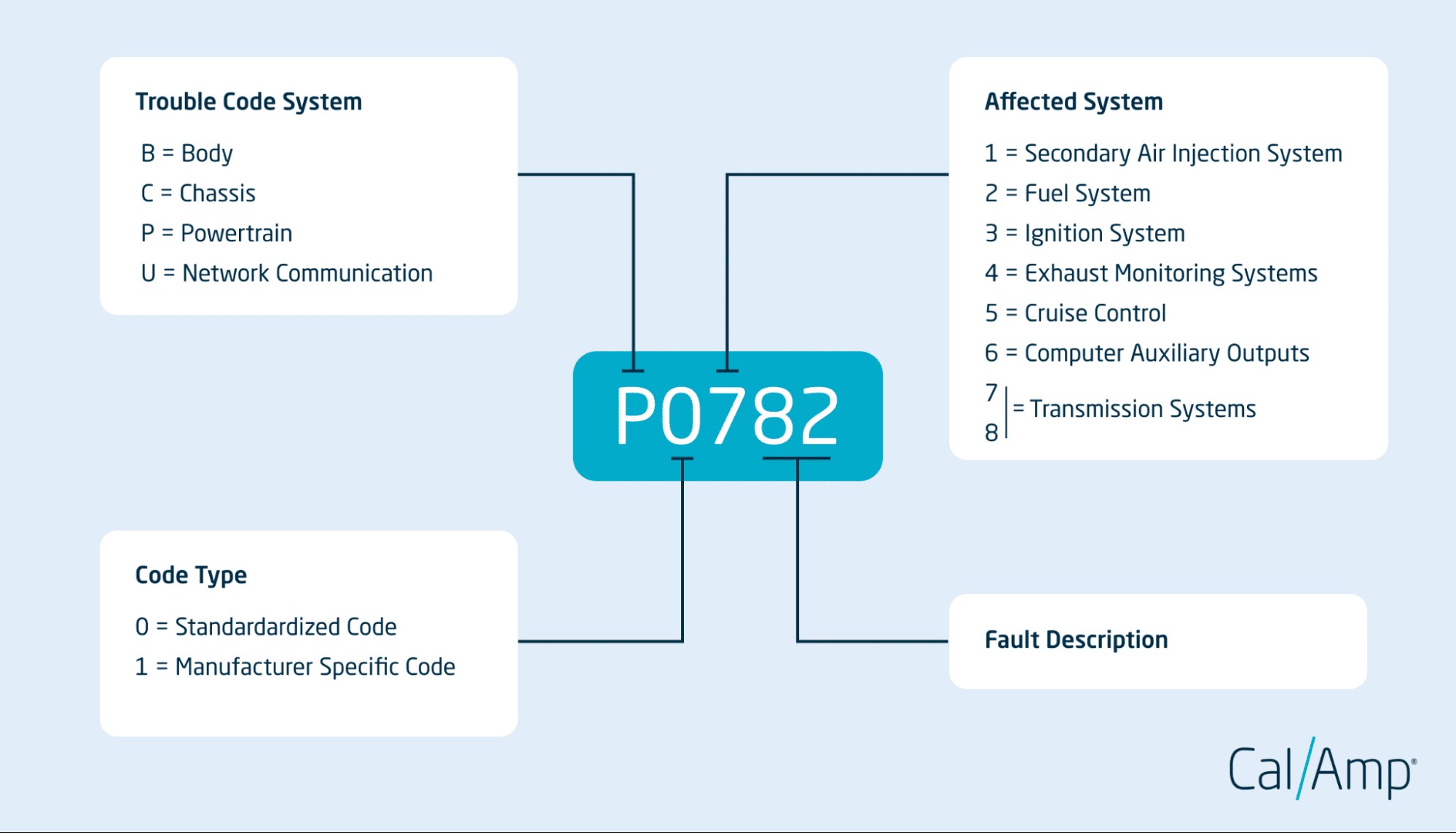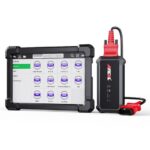As a vehicle owner or fleet manager, encountering an illuminated “Check Engine” light can be unsettling. This warning signal often accompanies a set of alphanumeric codes known as OBD2 codes. Understanding Obd2 Codes Meaning is essential for anyone looking to maintain vehicle health, diagnose issues effectively, and ensure smooth operation. This guide will delve into the world of OBD2 codes, explaining what they are, how to interpret them, and why they are crucial for modern vehicle maintenance.
Decoding OBD2 Codes: What You Need to Know
On-Board Diagnostics II (OBD2) is a standardized system implemented in most vehicles manufactured after 1996. Its primary function is to monitor various vehicle systems, from the engine and transmission to emissions control and beyond. When the OBD2 system detects a problem outside of normal parameters, it generates a diagnostic trouble code (DTC), commonly referred to as an OBD2 code.
What are OBD2 Codes?
OBD2 codes are essentially communication signals from your vehicle’s computer, indicating that something is not functioning as expected. Think of them as digital messages from your car, alerting you to potential issues that require attention. These codes are not descriptions of the problem itself, but rather clues that point towards the system or component experiencing a malfunction.
Modern vehicles are equipped with numerous sensors that constantly monitor performance and emissions. These sensors feed data to the vehicle’s Engine Control Module (ECM) or Powertrain Control Module (PCM), the central computer responsible for managing engine and transmission functions. When a sensor reading falls outside of pre-defined acceptable ranges, the ECM/PCM registers a fault and stores a corresponding OBD2 code. This, in turn, often triggers the “Check Engine” light or “Service Engine Soon” light on your dashboard, signaling that a diagnostic code has been recorded.
Types of OBD2 Codes
OBD2 codes are categorized into four main types, each designated by a letter as the first character of the five-character code. Understanding these categories helps narrow down the area of the vehicle experiencing the problem:
-
Powertrain Codes (P-Codes): These are the most common type of OBD2 codes and relate to issues within the engine, transmission, and associated drivetrain components. Powertrain problems can range from engine misfires and transmission faults to fuel system and emission control issues. For example, a P0300 code indicates a random engine misfire, while a P0700 code often signals a transmission control system malfunction.
-
Body Codes (B-Codes): Body codes pertain to systems within the vehicle’s body, such as airbags, power windows, electric seats, and climate control. A B0010 code, for instance, could indicate a problem with the driver’s side airbag sensor. Body codes often relate to comfort, convenience, and safety features of the vehicle.
-
Chassis Codes (C-Codes): Chassis codes relate to issues with the vehicle’s chassis systems, including braking, steering, suspension, and anti-lock braking system (ABS). A C0040 code might point to a problem with the right front wheel speed sensor, which is crucial for ABS and stability control systems. Chassis codes are often critical as they can affect vehicle handling and safety.
-
Network Communication Codes (U-Codes): Also known as network or communication codes, U-codes indicate problems within the vehicle’s communication network. Modern vehicles utilize complex networks (like CAN bus) to allow different modules to communicate with each other. U-codes signal a loss of communication between these modules. A common example is U0100, indicating a lost communication with the ECM/PCM, which can be caused by wiring issues, module malfunctions, or even a low battery.
Reading and Interpreting OBD2 Codes
OBD2 codes themselves are structured in a specific five-character format, which provides further information beyond just the general category. Understanding this structure allows for a more precise initial diagnosis.
Understanding the Structure of an OBD2 Code
Each of the five characters in an OBD2 code conveys specific information:
-
First Character: Trouble Code System Letter: As mentioned earlier, this letter designates the main system affected:
- P: Powertrain (Engine, Transmission)
- B: Body (Airbags, Accessories)
- C: Chassis (Brakes, Suspension, Steering)
- U: Network/Communication
-
Second Character: Code Type Digit: This digit indicates whether the code is generic or manufacturer-specific:
- 0: Generic or Standardized OBD2 Code (defined by SAE and common across all manufacturers). For example, P0171 (System Too Lean, Bank 1) is a generic code.
- 1: Manufacturer-Specific Code (defined by the vehicle manufacturer and specific to their models). For example, P1101 might be a Ford-specific code related to the Mass Air Flow sensor.
-
Third Character: Affected System Digit: This number further specifies the subsystem within the broader category identified by the first letter. Common affected systems are represented by numbers, for instance:
- 1: Fuel and Air Metering
- 2: Fuel and Air Metering (Injector Circuit)
- 3: Ignition System or Misfire
- 4: Auxiliary Emission Controls
- 5: Vehicle Speed Controls and Idle Control System
- 6: Computer Output Circuit
- 7, 8: Transmission
-
Fourth and Fifth Characters: Specific Code Digits: These last two digits are hexadecimal (0-9, A-F) and provide a highly specific identifier of the fault within the identified system and subsystem. For example, in the code P0420 (Catalyst System Efficiency Below Threshold Bank 1), “20” pinpoints the specific issue related to catalytic converter efficiency.
 What OBD2 codes mean
What OBD2 codes mean
Alt text: Decoding OBD2 Codes: Understanding the Five-Character Structure for Automotive Diagnostics
To read OBD2 codes, you will need an OBD2 scanner. These devices plug into the OBD2 port, typically located under the dashboard on the driver’s side of most vehicles. Once connected, the scanner can retrieve stored codes from the vehicle’s computer. Basic scanners will display the code itself, while more advanced scanners may provide a brief description of the code’s meaning.
Managing and Resolving OBD2 Codes
Once you have retrieved an OBD2 code, the next step is to understand its obd2 codes meaning in the context of your vehicle and decide on the appropriate course of action.
Clearing OBD2 Codes: When and How
Clearing OBD2 codes should generally be done after the underlying issue has been diagnosed and repaired. Simply clearing a code without addressing the problem will only result in the code and the “Check Engine” light reappearing. However, there are situations where clearing codes might be necessary or informative:
- After Repair: Once a repair is completed, clearing the code ensures that the “Check Engine” light turns off and the OBD2 system can monitor for new issues.
- Verification of Repair: Clearing the code and then performing a test drive can help verify if the repair was successful and if the code returns.
- Troubleshooting: In some diagnostic scenarios, clearing a code and seeing if it immediately returns can provide clues about intermittent faults or sensor issues.
There are three main methods for clearing OBD2 codes:
-
Using an OBD2 Scanner: Most OBD2 scanners, even basic models, have the function to clear codes. After retrieving the codes, navigate to the “clear codes” or “erase codes” option on the scanner menu and follow the prompts.
-
Drive Cycle: Some less critical OBD2 codes may clear themselves after a certain number of successful “drive cycles.” A drive cycle is a specific set of driving conditions (speed, duration, engine temperature, etc.) that allows the vehicle’s computer to re-run diagnostic tests. However, relying solely on drive cycles is not a reliable method for clearing codes, and it does not address the underlying problem.
-
Professional Mechanic: A mechanic can use professional-grade scan tools to diagnose the issue, perform repairs, and clear the OBD2 codes. This is the recommended approach if you are unsure about the diagnosis or if the code indicates a serious problem. Mechanics also have access to detailed repair information and diagnostic procedures.
Preventing OBD2 Codes: Proactive Maintenance
Prevention is always better than cure. Many OBD2 codes can be prevented by adhering to a regular vehicle maintenance schedule and using quality components. Proactive maintenance not only reduces the likelihood of triggering OBD2 codes but also extends the lifespan of your vehicle and improves its overall performance and reliability.
Two key aspects of preventing OBD2 codes are:
-
Regular Vehicle Maintenance: Following the manufacturer’s recommended maintenance schedule is crucial. This includes:
- Regular Oil Changes: Fresh, high-quality engine oil is vital for engine lubrication and preventing wear. Dirty or low oil can trigger codes related to engine performance and emissions.
- Air Filter Replacement: A clean air filter ensures proper airflow to the engine, improving fuel efficiency and reducing emissions. A clogged air filter can cause lean fuel conditions and trigger related codes.
- Spark Plug Inspection and Replacement: Worn or fouled spark plugs can cause engine misfires, a common cause of P-codes.
- Fluid Checks and Flushes: Regularly check and replace fluids like coolant, transmission fluid, brake fluid, and power steering fluid according to the manufacturer’s recommendations. Low or contaminated fluids can lead to system malfunctions and OBD2 codes.
- Routine Inspections: Regular inspections of belts, hoses, brakes, tires, and other components can identify potential problems before they escalate and trigger OBD2 codes.
-
Using Quality Fuel and Fluids: Using high-quality fuel and fluids is equally important:
- High-Quality Fuel: Use fuel from reputable gas stations and adhere to the octane rating recommended for your vehicle. Low-quality fuel can lead to incomplete combustion, engine deposits, and emissions problems, triggering OBD2 codes.
- Manufacturer-Recommended Fluids: Always use fluids that meet or exceed the specifications recommended by your vehicle manufacturer. Using incorrect or low-quality fluids can damage components and lead to various OBD2 codes related to engine, transmission, braking, and cooling systems.
OBD2 Codes and Vehicle Health
Understanding obd2 codes meaning empowers vehicle owners and fleet managers to take a proactive approach to vehicle maintenance. By promptly addressing OBD2 codes, you can:
- Prevent Minor Issues from Escalating: Early diagnosis and repair can prevent minor problems from turning into major, costly repairs.
- Improve Fuel Efficiency: Many OBD2 codes relate to engine performance and emissions, which directly impact fuel economy. Addressing these issues can improve fuel efficiency and save money on fuel costs.
- Reduce Emissions: OBD2 codes often relate to emission control systems. Repairing these issues helps ensure your vehicle is running cleaner and complying with emissions regulations.
- Extend Vehicle Lifespan: Regular maintenance and timely repairs based on OBD2 code information contribute to the overall longevity and reliability of your vehicle.
In conclusion, OBD2 codes are a valuable diagnostic tool built into modern vehicles. Learning to understand obd2 codes meaning, how to read them, and how to respond appropriately is an essential skill for anyone wanting to keep their vehicles running smoothly, efficiently, and reliably. Whether you are a vehicle owner or manage a fleet, mastering the basics of OBD2 codes is a worthwhile investment in vehicle health and preventative maintenance.

